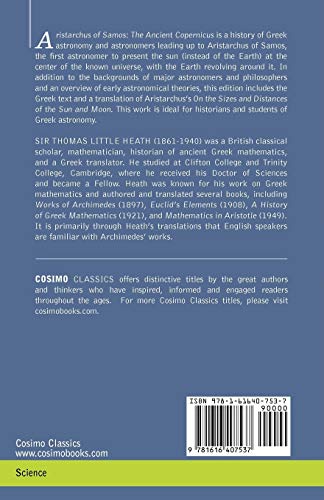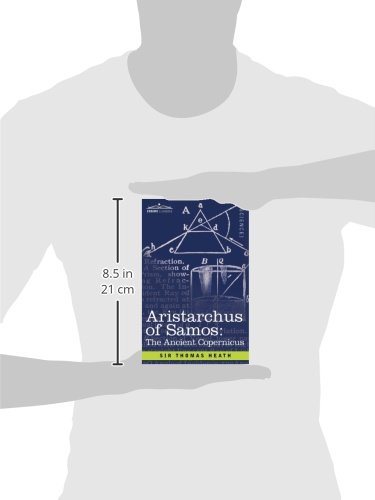Deliver to Cyprus
IFor best experience Get the App




Full description not available
N**F
What do we know that Aristarchus actually wrote?
Apart from the quote by Archimedes in his Sandreckoner,and much later comments by Plutarch and Vitruvius, this isit. You see Aristarchus here as a brilliant mind, and a fussy geometerwho also invented the method to determine pi that was followedup by Archimedes.Heath was a mathematician, who did not fully understand thesignificance of this man who showed that the Sun was so much biggerthan the Earth, so that it was only reasonable that Earth went round the Sun.Then the lack of an annual parallax showed that the stars were at vast distances.Sadly the result was screwed up by Hipparchos, who exactly like Tycho afterhim, thought that if he couldn't measure a parallax it was zero, rather thana very small number..If anyone wants to argue for theoreticians over observers, this issue isthe best example.The quotes from ancient astronomers and philosophers were fun.I did try once to set the record straight about Anaxagoras who startedthe investigation of physical measurements in the sky, but the wholestory really needs setting down in a popular book.
T**S
Interesting read that fills in a few historical blanks for ...
Interesting read that fills in a few historical blanks for me. It expands on the spectrum of scientific inquiry from the Francis Bacon method and Scientific Method that was the historical starting point for scientific inquiry as taught when I was in college.
J**L
Proto-trigonometry, and proofs of inequalities
The first part of this book is a competent survey of what the doxographic literature has to say about early astronomy. This is almost all speculative rather than observational or computational, except for some statements about cycles, like the common period stated by Oenopides for solar years and lunar months. But before we can make computational models we must have some feeling for what we are modeling, and it is useful to model the earth and planets as spheres. The importance of geocentrism vs. heliocentrism is exaggerated, I think. This is similar to how popular accounts of quantum mechanics fuss over waves vs. particles, rather than actually doing quantum mechanics.The second part of this book is a commentary on and translation of Aristarchus's "On the sizes and distances of the sun and moon". I don't know how important this is in the history of astronomy; my interest is in its mathematics. Aristarchus is talking about intersections of spheres, cones, and planes, and is doing proto-trigonometry. Moreover, he is working with inequalities of ratios, and proves the equivalent of things like the sine of 1 degree being greater than 1/20 and less than 1/18.Heath has a mastery of all the classical literature. There are few scholars now who have both the command of mathematics and astronomy that Heath had and the command of the doxographic literature and ancient writers like Strabo, Theon of Smyrna, Seneca, Geminus, Cleomedes, Ptolemy, Proclus, Macrobius, Martianus Capella, Censorinus, etc. The way to be great like this is to read attentively all extant ancient mathematical, astronomical, and physical works, and because this is so overwhelming a task there are few people who can do what Heath did. Moreover, writing about ancient astronomy doesn't just demand one to be able to follow the geometric reasoning, but to be at home doing the computations to say when eclipses occur and things like that: as a mathematician I can follow the proofs in Aristarchus, but I don't have any feeling for how one actually did ancient astronomy. The only book I've found that looks like it can teach this is Evans, The History and Practice of Ancient Astronomy , which I will have to read cover to cover if I ever do any work in the history of astronomy.Because Heath is the only English translation and nearly the only English commentary on Aristarchus, if you get stuck now you have to struggle through the text rather than checking someone else's explanation. It would be a useful project to work out a close reading of Aristarchus and draw new diagrams; this would certainly be a worthy article for a publication like the American Mathematical Monthly.By the way, it took me some time to figure out that "Let a plane be carried through AB" means "Let us be given a plane that contains the line AB", and this is any plane containing the line, not some particular plane. I took time to become comfortable with the diagrams because cones and spheres are being talked about, which made me expect perspective diagrams, but in fact the diagrams are on a plane.
V**O
On the distances and sizes of the sun and the moon
Although this book contains much historical background, the highlight, in my opinion, is the complete translation of Aristarchus' only extant work, On the distances and sizes of the sun and moon (c. -270). I am going to summarise this work here. My summary will contain all the main results of the treatise, and indicate what is essentially Aristarchus' derivations. However, my summary will be a simplification in that I will assume that the sun lights up exactly half the moon, whereas Aristarchus knows that this is not quite true and so has a small correction factor in the calculations to account for this.I will use this notation: E, M, S are the centers of the earth, moon and sun respectively, and E', M', S' are points on their apparent perimeters.The ratio of the distances from the earth to the moon and from the earth to the sun can be determined by measuring the angle MES at half moon. For at half moon the angle EMS=90° and the angle MES is measurable, so we know all angles of this triangle and thus the ratios of its sides.The ratio of the sizes of the moon and the sun can then be inferred at a solar eclipse. For at a solar eclipse, the moon precisely covers the sun. Thus EMM' is similar to ESS', with the scaling factor discovered above, i.e. SS':MM'::ES:EM.The ratio of the distance of the moon to its size can be inferred from its angular size. For the angle EMM'=90° and the angle MEM' is measurable, so we know all angles of this triangle and thus the ratios of its sides.These distances can be related to the radius of the earth at a lunar eclipse. For the shadow that the earth casts on the moon is about two moon-diameters wide. To incorporate this information into a similar triangles setup, let O be the point beyond the moon from which the earth has the same angular size as the sun (i.e. precisely blocks out the sun). Then SS':EE'::OS:OE. Now the algebra gets a little bit involved. We want to know the LHS so we have to reduce the RHS to a number, which we will do by expressing both OS and OE in terms of OM. From above we know SS':MM', and now we have OS:OM::SS':2MM', which enables us to express OS in terms of OM. To express OE in terms of OM we first note that OE=OM+EM. From above we know how to express EM in terms of ES, or, if we prefer, MS. But again from OS:OM::SS':2MM' we know OS=OM+MS in terms of OM, so we know MS in terms of OM, so we are done. OS:OE is now some multiple of OM over some multiple of OM, i.e. a number, so we have found SS':EE', i.e. we have expressed the size of the sun (and thereby the size of the moon, of course) in terms of the size of the earth.
S**.
See the Stars!!
Interesting gems in this!
Trustpilot
4 days ago
1 week ago